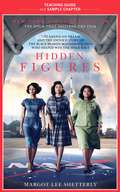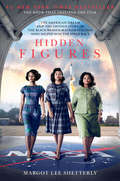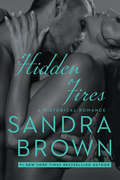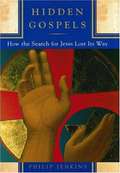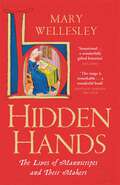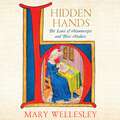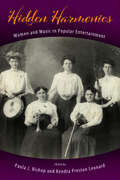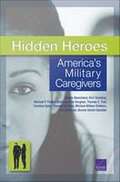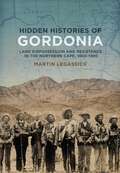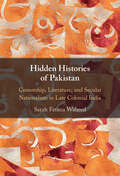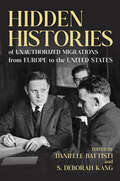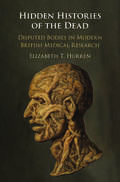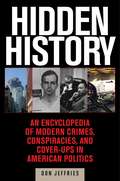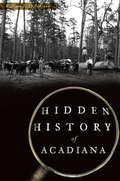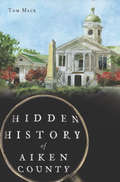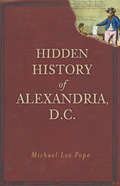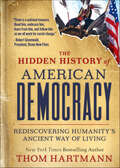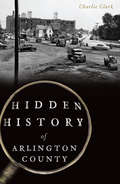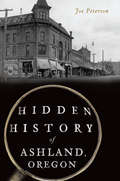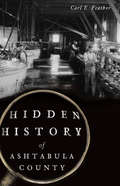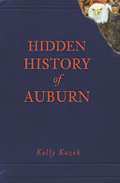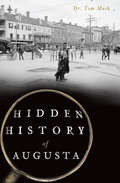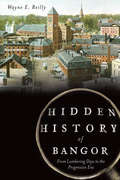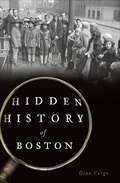- Table View
- List View
Hidden Designs: The Critical Profession and Renaissance Literature (Routledge Revivals)
by Jonathan CreweThis 1986 study offers a challenging contribution to the on-going critical debate surrounding the English literary Renaissance. Although informed by the ‘new historicism’ and post-structuralism, Hidden Designs makes a plea for criticism to be practiced in its own name rather than in the name of theory, and opposes the hyper-professionalisation of literary studies in favour of the broader communal functions of criticism. Major Renaissance authors and their recent critics are placed under ‘suspicion’ as Crewe explores the elements of ‘criminality’ inherent in the powerful interests –personal, institutional, political and cultural – served by the literary enterprise, or channelled through it. Revisionary readings of Sidney, Spenser, Puttenham and Shakespeare are linked by a continuing commentary on the history and theoretical claims of Renaissance criticism.
Hidden Figures Teaching Guide: Teaching Guide and Sample Chapter
by Margot Lee ShetterlyThe #1 New York Times bestsellerThe phenomenal true story of the black female mathematicians at NASA whose calculations helped fuel some of America’s greatest achievements in space. Soon to be a major motion picture starring Taraji P. Henson, Octavia Spencer, Janelle Monae, Kirsten Dunst, and Kevin Costner. Before John Glenn orbited the earth, or Neil Armstrong walked on the moon, a group of dedicated female mathematicians known as “human computers” used pencils, slide rules and adding machines to calculate the numbers that would launch rockets, and astronauts, into space. Among these problem-solvers were a group of exceptionally talented African American women, some of the brightest minds of their generation. Originally relegated to teaching math in the South’s segregated public schools, they were called into service during the labor shortages of World War II, when America’s aeronautics industry was in dire need of anyone who had the right stuff. Suddenly, these overlooked math whizzes had a shot at jobs worthy of their skills, and they answered Uncle Sam’s call, moving to Hampton, Virginia and the fascinating, high-energy world of the Langley Memorial Aeronautical Laboratory. Even as Virginia’s Jim Crow laws required them to be segregated from their white counterparts, the women of Langley’s all-black “West Computing” group helped America achieve one of the things it desired most: a decisive victory over the Soviet Union in the Cold War, and complete domination of the heavens. Starting in World War II and moving through to the Cold War, the Civil Rights Movement and the Space Race, Hidden Figures follows the interwoven accounts of Dorothy Vaughan, Mary Jackson, Katherine Johnson and Christine Darden, four African American women who participated in some of NASA’s greatest successes. It chronicles their careers over nearly three decades they faced challenges, forged alliances and used their intellect to change their own lives, and their country’s future.
Hidden Figures: The American Dream and the Untold Story of the Black Women Mathematicians Who Helped Win the Space Race
by Margot Lee Shetterly<P>The phenomenal true story of the black female mathematicians at NASA whose calculations helped fuel some of America's greatest achievements in space. Soon to be a major motion picture starring Taraji P. Henson, Octavia Spencer, Janelle Monae, Kirsten Dunst, and Kevin Costner. <P>Before John Glenn orbited the earth, or Neil Armstrong walked on the moon, a group of dedicated female mathematicians known as "human computers" used pencils, slide rules and adding machines to calculate the numbers that would launch rockets, and astronauts, into space. Among these problem-solvers were a group of exceptionally talented African American women, some of the brightest minds of their generation. <P>Originally relegated to teaching math in the South's segregated public schools, they were called into service during the labor shortages of World War II, when America's aeronautics industry was in dire need of anyone who had the right stuff. Suddenly, these overlooked math whizzes had a shot at jobs worthy of their skills, and they answered Uncle Sam's call, moving to Hampton, Virginia and the fascinating, high-energy world of the Langley Memorial Aeronautical Laboratory. <P>Even as Virginia's Jim Crow laws required them to be segregated from their white counterparts, the women of Langley's all-black "West Computing" group helped America achieve one of the things it desired most: a decisive victory over the Soviet Union in the Cold War, and complete domination of the heavens. <P>Starting in World War II and moving through to the Cold War, the Civil Rights Movement and the Space Race, Hidden Figures follows the interwoven accounts of Dorothy Vaughan, Mary Jackson, Katherine Johnson and Christine Darden, four African American women who participated in some of NASA's greatest successes. It chronicles their careers over nearly three decades they faced challenges, forged alliances and used their intellect to change their own lives, and their country's future.
Hidden Fires
by Sandra BrownIn a Texas of cattle and railroads, family dynasties and ambitious schemers, Sandra Brown's classic historical romance brings readers a riveting story ...
Hidden Gospels: How the Search for Jesus Lost Its Way
by Philip JenkinsThis incisive critique thoroughly and convincingly debunks the claims that recently discovered texts such as the Gospel of Thomas, the Gospel of Mary, and even the Dead Sea Scrolls undermine the historical validity of the New Testament.
Hidden Hands: The Lives of Manuscripts and Their Makers
by Mary WellesleyManuscripts teem with life. They are not only the stuff of history and literature, but they offer some of the only tangible evidence we have of entire lives, long receded. Hidden Hands tells the stories of the artisans, artists, scribes and readers, patrons and collectors who made and kept the beautiful, fragile objects that have survived the ravages of fire, water and deliberate destruction to form a picture of both English culture and the wider European culture of which it is part.Without manuscripts, she shows, many historical figures would be lost to us, as well as those of lower social status, women and people of colour, their stories erased, and the remnants of their labours destroyed.From the Cuthbert Bible, to works including those by the Beowulf poet, Margery Kempe, Julian of Norwich, Sir Thomas Malory, Chaucer, the Paston Letters and Shakespeare, Mary Wellesley describes the production and preservation of these priceless objects. With an insistent emphasis on the early role of women as authors and artists and illustrated with over fifty colour plates, Hidden Hands is an important contribution to our understanding of literature and history.
Hidden Hands: The Lives of Manuscripts and Their Makers
by Mary WellesleyManuscripts teem with life. They are not only the stuff of history and literature, but they offer some of the only tangible evidence we have of entire lives, long receded. Hidden Hands tells the stories of the artisans, artists, scribes and readers, patrons and collectors who made and kept the beautiful, fragile objects that have survived the ravages of fire, water and deliberate destruction to form a picture of both English culture and the wider European culture of which it is part.Without manuscripts, she shows, many historical figures would be lost to us, as well as those of lower social status, women and people of colour, their stories erased, and the remnants of their labours destroyed.From the Cuthbert Bible, to works including those by the Beowulf poet, Margery Kempe, Julian of Norwich, Sir Thomas Malory, Chaucer, the Paston Letters and Shakespeare, Mary Wellesley describes the production and preservation of these priceless objects. With an insistent emphasis on the early role of women as authors and artists, Hidden Hands is an important contribution to our understanding of literature and history.(P) 2021 Quercus Editions Limited
Hidden Harmonies: Women and Music in Popular Entertainment (American Made Music Series)
by Paula J. Bishop and Kendra Preston LeonardContributions by Christina Baade, Candace Bailey, Paula J. Bishop, Maribeth Clark, Brittany Greening, Tammy Kernodle, Kendra Preston Leonard, April L. Prince, Travis D. Stimeling, and Kristen M. TurnerFor every star, there are hundreds of less-recognized women who contribute to musical communities, influencing their aesthetics and expanding opportunities available to women. Hidden Harmonies: Women and Music in Popular Entertainment focuses not on those whose names are best known nor most celebrated but on the women who had power in collective or subversive ways hidden from standard histories.Contributors to Hidden Harmonies reexamine primary sources using feminist and queer methodologies as well as critical race theory in order to overcome previous, biased readings. The scholarship that results from such reexaminations explores topics from songwriters to the music of the civil rights movement and from whistling schools to musical influencers. These wide-ranging essays create a diverse and novel view of women's contribution to music and its production. With intelligence and care, Hidden Harmonies uncovers the fascinating figures behind decades of popular music.
Hidden Heroes: America's Military Caregivers
by Terri Tanielian Rajeev Ramchand Michael P. Fisher Christine Anne Vaughan Thomas E. Trail Caroline Epley Phoenix Voorhies Michael William Robbins Eric Robinson Bonnie Ghosh-DastidarLittle has been reported about "military caregivers"--the population of those who care for wounded, ill, and injured military personnel and veterans. This report summarizes the results of a study designed to describe the magnitude of military caregiving in the United States today, as well as to identify gaps in the array of programs, policies, and initiatives designed to support military caregivers.
Hidden Histories of Gordonia: Land dispossession and resistance in the Northern Cape, 1800–1990
by Martin LegassickThe Gordonia region of the Northern Cape province has received relatively little attention from historians. In Hidden Histories of Gordonia: Land dispossession and resistance in the Northern Cape, 1800–1990, Martin Legassick explores aspects of the generally unknown ‘brown’ and ‘black’ history of the region. Emphasising the lives of ordinary people, his writing is also in part an exercise in ‘applied history’ – historical writing with a direct application to people’s lives in the present.Tracing the indigenous history of Gordonia as well as the northward movement of Basters and whites from the western Cape through Bushmanland to the Orange River, the book presents accounts of family histories, episodes of indigenous resistance to colonisation, and studies of the ultimate imposition of racial segregation and land dispossession on the inhabitants of the region. A recurrent theme is the question of identity and how the extreme ethnic fluidity and social mixing apparent in earlier times crystallised in the colonial period into racial identities, until with final conquest came imposed racial classification.
Hidden Histories of Pakistan: Censorship, Literature, and Secular Nationalism in Late Colonial India
by Sarah Fatima WaheedCensorship, Urdu literature, Islam, and progressive secular nationalisms in colonial India and Pakistan have a complex, intertwined history. Sarah Waheed offers a timely examination of the role of progressive Muslim intellectuals in the Pakistan movement. She delves into how these left-leaning intellectuals drew from long-standing literary traditions of Islam in a period of great duress and upheaval, complicating our understanding of the relationship between religion and secularism. Rather than seeing 'religion' and 'the secular' as distinct and oppositional phenomena, this book demonstrates how these concepts themselves were historically produced in South Asia and were deeply interconnected in the cultural politics of the left. Through a detailed analysis of trials for blasphemy, obscenity and sedition, and feminist writers, Waheed argues that Muslim intellectuals engaged with socialism and communism through their distinctive ethical and cultural past. In so doing, she provides a fresh perspective on the creation of Pakistan and South Asian modernity.
Hidden Histories of Unauthorized Migrations from Europe to the United States (Studies of World Migrations)
by S. Deborah Kang Mary Patrice Erdmans Danielle Battisti Joanna Wojdon Ashley Johnson Bavery Carly Goodman Torsten Feys Randa Tawil Polina Ermoshkina E. Kyle RomeroOften depicted as the nation’s iconic legal immigrant, unauthorized European migrants are often overlooked by scholars, policymakers, and the media. This volume tells the stories of European migrants who adopted irregular migration strategies to enter and remain in the United States throughout the twentieth century. Contributors explore facets of this history with essays on migration patterns from Russia, Italy, Ireland, the Ottoman Empire, and Poland. They also offer important arguments about the treatment of unauthorized European migrants by states and societies on both sides of the Atlantic and how the reception of undocumented immigrants has been and continues to be impacted by the dynamics of racial, class, and gender constructions in the United States and abroad. As the contributors show, the reception accorded unauthorized European migrants frequently obscured and even normalized their irregular migration strategies, easing their access to American citizenship. Revealing and insightful, Hidden Histories of Unauthorized Migrations from Europe to the United States sheds new light our intertwined notions of race, legality, and immigration. Contributors: Danielle Battisti, Ashley Johnson Bavery, Mary Patrice Erdmans, Polina Ermoshkina, Torsten Feys, Carly Goodman, S. Deborah Kang, E. Kyle Romero, Randa Tawil, and Joanna Wojdon
Hidden Histories of the Dead: Disputed Bodies in Modern British Medical Research
by Elizabeth T. HurrenIn this discipline-redefining book, Elizabeth T. Hurren maps the post-mortem journeys of bodies, body-parts, organs, and brains, inside the secretive culture of modern British medical research after WWII as the bodies of the deceased were harvested as bio-commons. Often the human stories behind these bodies were dissected, discarded, or destroyed in death. Hidden Histories of the Dead recovers human faces and supply-lines in the archives that medical science neglected to acknowledge. It investigates the medical ethics of organ donation, the legal ambiguities of a lack of fully-informed consent and the shifting boundaries of life and re-defining of medical death in a biotechnological era. Hurren reveals the implicit, explicit and missed body disputes that took second-place to the economics of the national and international commodification of human material in global medical sciences of the Genome era. This title is also available as Open Access.
Hidden History
by Donald JeffriesThe US government has spent half the time covering up conspiracies as it has spent helping the American people. In Hidden History, you will see the amount of effort over the past fifty years that our government has dedicated to lying and covering up the truth to the world.Starting with the assassination of President John F. Kennedy, Don Jeffries chronicles a wide variety of issues that have plagued our country's history. Whether it's the assassinations of MLK and RFK, Iran-Contra, the Oklahoma City bombing, TWA Flight 800, voting fraud, or 9/11, every major disaster or war that we've witnessed has somehow been distorted by those who are supposed to be protecting us.Jeffries also delves into extensive research on the death of John F. Kennedy Jr., and you'll be shocked by what he finds out.So whether you've only heard bits and pieces of these stories or have read several books on the topics, Hidden History is the book that belongs in every conspiracy theorist's library, as the information included in this encyclopedia has never been collected together in any other published work available. So sit down, strap in, and get ready to be shocked and awed by how much has been hidden from you by our government over the past fifty years.
Hidden History of Acadiana (Hidden History)
by William J. ThibodeauxTragedy and destruction abound in this region and in these pages, but heroism, glory and Cajun flair come in equal measure. From the improbable Thoroughbred Twenty-Twoinit, which defied odds and burned Vegas oddsmakers at Evangeline Downs, to the destitute Reconstruction-era Cajuns who sought recompense from the federal government after the war, history comes to life in these retellings by historian and yarn spinner William Thibodeaux. Before "serial killer" was a term, a vile murderer stalked the streets of then-tiny Lafayette, inciting unimaginable terror. All too familiar are harrowing tales of locals who battened down the hatches as horrible storms roared forth. From the hills to the bayous, Acadiana has quite a story to tell, especially for those who lean in close to listen.
Hidden History of Aiken County (Hidden History)
by Dr. Tom MackSituated between the mountains and the coast, Aiken County attracted ailing members of the southern planter class once the railroad from Charleston to Hamburg was completed in 1833. After the Civil War, grand hotels and sporting activities drew wealthy northern capitalists south for the winter here. A third era of prosperity came in the 1950s, when the Cold War prompted the construction of a nuclear reservation. Local author Tom Mack uncovers the lesser-known stories behind the major events that shaped the area's colorful past. Meet inventor James Legare, political insider George Croft and singing sensation Arthur Lee Simpkins. Learn about the controversial Graniteville murder of 1876 and how an abdicated king found solace in Aiken in 1936. And discover so many more interesting stories.
Hidden History of Alexandria, D.C. (Hidden History)
by Michael Lee PopeThis groundbreaking history uncovers a long-forgotten period in the 19th century when Alexandria left the commonwealth of Virginia and became incorporated into the fledgling District of Columbia. It was an experiment that failed after half a century of neglect and a growing animosity between North and South. However, it was a fascinating time when cannon were dragged onto city streets for political rallies, candidates plied their voters with liquor and devastating fires ravaged the city.
Hidden History of American Democracy: Rediscovering Humanity's Ancient Way of Living
by Thom HartmannAmerica's most popular progressive radio host and New York Times bestselling author Thom Hartmann paves the way to saving our democracy. In this powerful, sweeping history and analysis of American democracy, Thom Hartmann shows how democracy is the one form of governance most likely to produce peace and happiness among people. With the violent exception of the Civil War, American democracy resisted the pressure to disintegrate into factionalism for nearly two centuries, and now our very system of democratic elections is at stake. So how do we save our democracy? Hartmann's newest book in the celebrated Hidden History Series offers a clear call to action and a set of solutions with road maps for individuals and communities to follow to create a safer, more just society and a more equitable and prosperous economy.
Hidden History of Arlington County (Hidden History)
by Charlie ClarkArlington County, for two centuries a center for government institutions, is a vibrant part of the Washington, D.C., community. Many notable figures made their home in the area, like Supreme Court chief justice Warren Burger, General George “Blood ’n’ Guts” Patton and a beauty queen who almost married crooner Dean Martin. The drama of Virginia’s first school integration unfolded in Arlington beginning in the late 1950s. In the 1960s, two motorcycle gangs clashed in public at a suburban shopping center. Local author, historian and “Our Man in Arlington” Charlie Clark uncovers the vivid, and hidden, history of a capital community.
Hidden History of Ashland, Oregon (Hidden History)
by Joe PetersonFamous for the Oregon Shakespeare Festival, Ashland has a deep history that goes far beyond the stage. From a 160-year-old unsolved murder to a newcomer whose "healing hands" drew people from all over the country, the town has attracted its fair share of unique characters. Vladimir Nabokov came to pursue his favorite hobby, butterfly collecting, while writing his famously controversial novel, Lolita, and an actor turned entrepreneur became one of the foremost recyclers long before it was mainstream. Discover the story behind Ashland's golf course cemetery and the gloveless baseball team of 1884. Join local historian Joe Peterson as he explores the fascinating past of this colorful town.
Hidden History of Ashtabula County (Hidden History)
by Carl E. FeatherPicturesque Ashtabula County harbors a rich and sometimes strange history. Ohio's Western Reserve settlers were astonished by the ancient graveyards they found that yielded bones belonging to a gigantic race. Mr. Buck of Conneaut lived a secluded life married to himself, assuming the character and dress of the fictional Mrs. Buck. A legend persists to this day that the ship of a Spanish princess lies at the bottom of Pymatuning Lake. Author Carl E. Feather delves into the rich history of Ohio's largest county and uncovers its little-known secrets in the most unexpected places.
Hidden History of Auburn (Hidden History)
by Kelly KazekAuburn is not just the home to a world-class university; it is also the home of a storied community with deep roots in Alabama history. Join author and Auburn University alumna Kelly Kazek as she tracks the lesser-known history of both the city and the school. In this diverse collection of lost, forgotten or just plain strange history, Kazek uses her decades of experience as a journalist to dig deep and cast a wide net, revealing stories sure to surprise even the most seasoned Auburn experts. From the mysterious origins of some of AU's most hallowed traditions to tales that stretch back to the very founding of the city, Hidden History of Auburn is an unprecedented collection that unearths the long-buried stories of this Alabama treasure.
Hidden History of Augusta (Hidden History)
by Dr Tom MackSituated along the Georgia border, Augusta is known for its golf, beautiful private gardens and southern culture. But its history is also brimming with strange stories yet to be told. A beleaguered German princess gave the city its name. A "haunted pillar" survived a tornado that destroyed the area in 1878. The famous Wright brothers opened a branch of their flying school here in 1911. Author and historian Tom Mack uncovers and celebrates these gems hidden in Augusta's rich and teeming history.
Hidden History of Bangor: From Lumbering Days to the Progressive Era (Hidden History)
by Wayne E. ReillyWhen celebrity aviator Harry Atwood made the first aeroplane flight over Bangor in 1912, observers were astonished. It was a sign that the city had recovered from the great fire of 1911 that had destroyed its downtown the year before. While some events are well known, many stories from turn-of-the-century Bangor have been lost to time. In this collection, local author Wayne E. Reilly brings some of the most exciting and intriguing hidden Bangor tales to light--from a gas explosion that left a thirty-foot crater in the middle of downtown to the escape of a mayor's pet pig. Join Reilly as he reveals the hidden stories from Queen City history.
Hidden History of Boston: History Through Architecture (Hidden History)
by Dina VargoQuirky and little-known true stories of one of America&’s most historic cities. Boston may play a big role in American history textbooks, but it also has quite a bit of forgotten past. For example, during the colonial era, riotous mobs celebrated their hatred of the pope in an annual celebration called Pope&’s Night. In 1659, Christmas was made illegal, a ban by the Puritans that remained in effect for twenty-two years. William Monroe Trotter published the Boston Guardian, an independent African American newspaper, and was a beacon of civil rights activism at the turn of the century. And in more recent times, a centuries-long turf war played out on the streets of quiet Chinatown, ending in the massacre of five men in a back alley in 1991. Author and historian Dina Vargo shines a light into the cobwebbed corners of Boston&’s hidden history in this riveting read, complete with illustrations.

